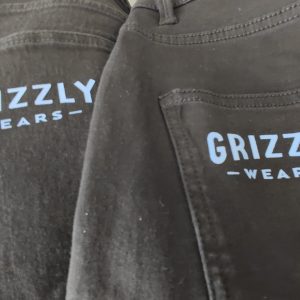What is Sustainable Clothing ?
Many people wonder what Sustainable clothing actually is. I may have a different definition to a lot of people but in simplest terms:
Clothing made from renewable sources with little social and environmental impact
There are several key words in this sentence that help to define the sustainable elements of the clothing. Firstly “renewable”, indicating that the raw material must be able to be regrown or recreated. Secondly “social” in reference to the impact on the people involved making it. Next “environment”, the area and ultimately the world. Lastly “impact”, the often negative side effects related to production.
Sustainable clothing and products for that matter, should be made entirely of renewable materials where possible. There is definitely a scale of Sustainability and it is not always as clear as you initially may think. I have learnt many things through research and development of the Grizzly Wears Clothing brand. All materials have their positive and negative attributes. These attributes may be related to production or performance. Identifying as an outdoor/sportswear brand means that my products have to meet a certain level of performance. Traditional technical fabrics such as Polyester and Nylon carry a certain level of environmental impact…
… Or do they ?
There is no denying the impact of oil-based fabrics. Fabrics produced this way are not sustainable. They do require energy and resources to be produced, they are not biodegradable. However these fabrics are recyclable. When clothing reaches the end of its life it can be turned into pellets. These are used to produce more clothing. This is a Closed Loop or circular ecosystem. It isn’t perfect yet and requires new material to be added during the recycling. It does make use of waste products normally destined for landfill. Preventing waste going directly to landfill is good. Recycling that item to give it another life is great.
Utilising recycled polyester over virgin polyester reduces energy consumption by 79%. Requirements for raw materials are reduced. Waste bound for landfill is reduced. Furthermore, less land is needed to farm organic materials. These are all great benefits to fabrics which, at first glance, seem unsustainable.

So why use organic fabrics ?
Natural fabrics are naturally more sustainable. They are biodegradable, reducing the need to recycle. On the down side they do require land, water, pesticides, fertilisers to grow. Due to over farming the soil is running out of nutrients to grow plants further creating need for fertilisers. These fabrics have certain performance qualities related to what they are made from. Often inferior to man made fabrics.
Cotton is a fantastic material. It is biodegradable. It is comfortable. The human race has a 7000+ year history of producing cotton. Also recyclable. Cotton is the fastest drying natural fabric. I doubt anybody reading this does not own clothing made of cotton. Properties of cotton make it great for every day wear and light sports. When used for long, high intensity cotton does have limitations. This is where making use of recycled polyester becomes applicable.
Bamboo also has great properties. There are two main types of bamboo fabric, the difference being mainly related to production. When raw bamboo is broken down via chemicals we get Bamboo Viscose. On the downside the impact of these chemicals is not fully understood. They can harm the environment or workers when proper care is not taken. Bamboo Lyocell is refined by mechanically breaking down raw bamboo. This method reduces need for harmful chemicals.
When comparing cotton with bamboo fabric we need to look at the overall picture. Bamboo requires more refining. Cotton requires more resources to grow. Choosing a winning fabric between these two is difficult. Each has good qualities for certain use. Bamboo and cotton as raw materials are sustainable and renewable. They both need land to be grown. Cotton needs more land, more water, more fertiliser and pesticide. Most importantly, a balanced approach is the best way to view all fabrics.
Can you mix fabrics to be sustainable and high performance ?
Yes, and no. Firstly, mixing two natural materials will result in a biodegradable material. Secondly mixing a natural material with a man made material will result in a fabric that is not biodegradable or recyclable. Finally, mixing two man made fabrics means they can no longer be recycled.
Aiming to produce products that are sustainable means we can not use blended fabrics unless both are biodegradable. There are a lot of brands who do this because it does give desired results. As a brand aiming to make only the most sustainable clothing this is something we can not do. If technology is developed to allow these fabrics to be recycled we will look towards using them. As far as I am aware this is not possible.
So what is Sustainable Clothing ?
Sustainable clothing is a balanced approach taken with an open mind and research.
In conclusion, Grizzly Wears Clothing is built on honesty and balance. By identifying the qualities needed by an item of clothing, I source the appropriate fabric. If I can not make an item sustainably I will not make it at all. Lastly every fabric is chosen for its properties and environmental benefits.
Grizzly Wears only gets one go at being a brand that never made an unsustainable product. By sticking to high sustainable, ethical and environmental standards I hope to lead the way. I see the way forwards as balance. Use all the technology we have to recycle and sustainably produce better clothing. Being transparent and giving the consumer facts about what I choose to make clothes from rather than only providing benefits to let people make a fair, balanced decision.
-
 Grizzly Bars – Woodland Walk£6.00
Grizzly Bars – Woodland Walk£6.00 -
 Grizzly Bars – Recover£6.00
Grizzly Bars – Recover£6.00 -
 Grizzly Bars – Pirate£6.00
Grizzly Bars – Pirate£6.00 -
 Grizzly Bars – Old Sea Dog£6.00
Grizzly Bars – Old Sea Dog£6.00 -
 Grizzly Bars – Happy£6.00
Grizzly Bars – Happy£6.00 -
 Grizzly Bars – Energise£6.00
Grizzly Bars – Energise£6.00 -
 Grizzly Bars – Whisky£6.00
Grizzly Bars – Whisky£6.00 -
 Ocean Plastic & Bamboo Sunglasses£10.00
Ocean Plastic & Bamboo Sunglasses£10.00 -
 Every Day Jeans£45.00
Every Day Jeans£45.00









